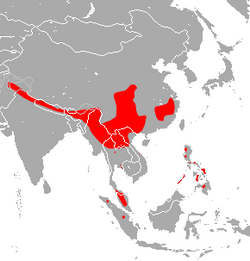Biology:Big-eared horseshoe bat
| Big-eared horseshoe bat | |
|---|---|
| Scientific classification | |
| Domain: | Eukaryota |
| Kingdom: | Animalia |
| Phylum: | Chordata |
| Class: | Mammalia |
| Order: | Chiroptera |
| Family: | Rhinolophidae |
| Genus: | Rhinolophus |
| Species: | R. macrotis
|
| Binomial name | |
| Rhinolophus macrotis Blyth, 1844
| |

| |
| Big-eared horseshoe bat range | |
The big-eared horseshoe bat (Rhinolophus macrotis) is a bat species within the Rhinolophidae native to Asia.[1]
Taxonomy
The big-eared horseshoe bat was described as a new species in 1844 by English zoologist Edward Blyth. The holotype had been collected by Brian Houghton Hodgson in Nepal.[2] The species name "macrotis" is from Ancient Greek makrós meaning "long" and oûs meaning "ear".[3] It contains many subspecies; a 2008 paper listed seven such subspecies:[4]
- R. m. macrotis Blyth, 1844
- R. m. episcopus Allen, 1923
- R. m. caldwelli Allen, 1923
- R. m. siamensis Gyldenstolpe, 1917
- R. m. dohrni Andersen, 1907
- R. m. hirsutus Andersen, 1905
- R. m. topali Csorba & Bates, 1995
R. m. hirsutus, R. m. episcopus were originally described as full species, but George Henry Hamilton Tate included them as subspecies of R. macrotis in a 1943 publication. In the same publication, Tate included R. m. caldwelli as a subspecies; previously, it was considered a subspecies of R. episcopus.[5][6] Most recently, R. m. siamensis has been considered a full species rather than a subspecies, known as the Thai horseshoe bat.[5]
Description
The big-eared horseshoe bat can be differentiated from other horseshoe bats by its very long ears and a tongue-shaped sella that is long and broad.[5]
Range and habitat
The big-eared horseshoe bat is found in several countries in South and Southeast Asia including Bangladesh, China , India , Indonesia, Laos, Malaysia, Myanmar, Nepal, Pakistan , Philippines , Thailand, and Vietnam. As of 2008, its presence was possible but not confirmed in Bhutan. It has been documented at a range of elevations from 200–1,692 m (656–5,551 ft) above sea level.[1]
References
- ↑ 1.0 1.1 1.2 Tu, V.; Csorba, G.; Srinivasulu, C. (2019). "Rhinolophus macrotis". IUCN Red List of Threatened Species 2019: e.T19550A21978583. doi:10.2305/IUCN.UK.2019-3.RLTS.T19550A21978583.en. https://www.iucnredlist.org/species/19550/21978583. Retrieved 15 November 2021.
- ↑ Blyth, Edward (1844). "Notices of various Mammalia, with descriptions of many new species". The Journal of the Asiatic Society of Bengal 13: 485–486. https://biodiversitylibrary.org/page/40057312.
- ↑ Natural History Society of Montreal (1857). The Canadian Naturalist and Geologist. Dawson. p. 92. https://archive.org/details/canadiannatural02unkngoog.
- ↑ Sun, Ke-Ping; Feng, Jiang; Jiang, Ting-Lei; Ma, Jie; Zhang, Zhen-Zhen; Jin, Long-Ru (2008). "A new cryptic species of Rhinolophus macrotis (Chiroptera: Rhinolophidae) from Jiangxi Province, China". Acta Chiropterologica 10: 1–10. doi:10.3161/150811008X331045.
- ↑ 5.0 5.1 5.2 Tu, Vuong Tan; Hassanin, Alexandre; Görföl, Tamás; Arai, Satoru; Fukui, Dai; Thanh, Hoang Trung; Son, Nguyen Truong; Furey, Neil M. et al. (2017). "Integrative taxonomy of the Rhinolophus macrotis complex (Chiroptera, Rhinolophidae) in Vietnam and nearby regions". Journal of Zoological Systematics and Evolutionary Research 55 (3): 177–198. doi:10.1111/jzs.12169. http://real.mtak.hu/67328/1/Tu_et_al_2017_Integrative_taxonomy_of_the_Rhinolophus_macrotis_complex_in_Vietnam_and_nearby_regions_u.pdf.
- ↑ Allen, G. M. (1923). "New Chinese Bats". American Museum Novitates (85): 3. http://digitallibrary.amnh.org/bitstream/handle/2246/4661//v2/dspace/ingest/pdfSource/nov/N0085.pdf?sequence=1&isAllowed=y.
Wikidata ☰ Q1764267 entry
 |


